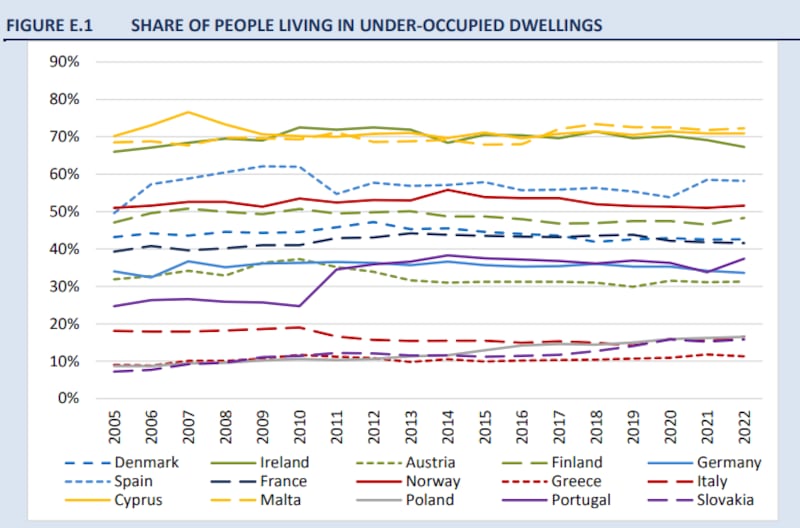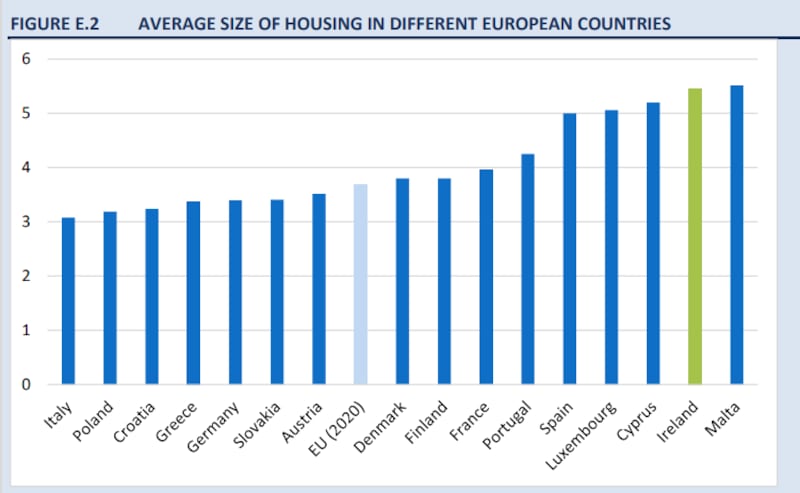Two-thirds of Irish people are rattling around in homes that are “too big for their needs”, new research has found. A report by the Economic and Social Research Institute (ESRI) says that the average Irish home is 5.5 rooms, compared with the EU average of 3.7 rooms. When you remove renters from the “under-occupancy” figure, it shoots up to 80 per cent. Across the EU just one in three people are living in too-big homes.
It is tempting to see this as a side effect of the Irish McMansion phenomenon, the one-off large, statement homes pockmarking rural Ireland – with their sharp angles and occasional proliferation of columns and pillars seeming to emulate a raised middle finger to those who will never own a home.
But houses in Irish cities are also too large for the average person’s need; “Ireland has one of the highest under-occupancy rates in cities,” the ESRI reports. In truth, McMansions are merely one of the more visible symbols of a deep-rooted crisis in planning.

Under-occupancy, suggests the ESRI, may be a product of “specific cultural norms” including “the preference for houses over apartments”. I suspect it’s less about cultural preferences and more about a failure to plan for the blindingly obvious. You don’t need to be a Nobel prize-winning economist to follow the conclusion of the ESRI report: “as families grow larger, there is a need for additional rooms, while fewer rooms are needed as a household shrinks.”
READ MORE
This is a problem in a country where housing stock comprises 90 per cent houses and 10 per cent apartments and most new developments are build-to-rent. And so 88 per cent of over-65s are living in houses that are too big for them. With an ageing population, and three in four houses having two or more bedrooms, that figure is only going in one direction. The result is that young adults in their 20s and 30s – as well as returning emigrants – are locked out of the housing market while their parents are locked into sprawling homes that are expensive to heat and run.

The oft-touted solution is downsizing, a word easy to throw around but difficult to execute; I know, because my family did actually manage to do it. Six years ago, my parents sold the family home to us.
The first thing everyone asks is about the emotional side; whether it was a wrench for my parents; whether it feels strange to be back living in the house where I grew up. But they were ready to move, as ready as you can ever be, and had wanted to downsize for a while. We had recently returned from abroad and were renting a cramped holiday home while spending our weekends traipsing ever more despondently around open houses. We all loved the house where I grew up. In hindsight, the solution was so obvious it is astonishing now that it took us almost a year to get there.
Over lunch, we agreed to the price suggested by an independent valuation and set a deadline of Christmas. The only question, then, was where my parents would live.
They wanted fewer rooms, but not less privacy or comfort. My mother has always had a beautiful garden, so space outside to start again was crucial. An apartment wouldn’t work, not that there were any for sale in the area. They didn’t want to tackle a building project, but the dearth of alternatives ultimately meant they had no choice. With no downsizing grants or even short-term lending facilities to help fund the building work, everything had to stay on deadline. Eventually, we ended doing a short-term house swap. We moved out of our rental home and into the family home; on the same day, my parents moved into the rental we had just vacated, where they lived for a few months while their renovation finished.
There are lots of reasons why older adults whose families are grown and living independently might not want to move house. Just one is the ever-increasing likelihood that their children are grown, but not in fact living independently. Or they are living independently – but in such precarious circumstances that they might, any day now, return armed with a duvet, a monstera plant and yet another landlord horror story. Then there is the stress of moving; the lack of choice of smaller properties such as bungalows or small townhouses; the chance that they might not be able to afford even something much smaller in their own neighbourhood.
[ Housing crisis: We need to stop building assets and start building communitiesOpens in new window ]
But the State needs to start facilitating downsizing for those who would consider it. This means planning for housing that accommodates people at all stages in life – young families, retirees, couples and individuals without children – instead of just building apartments to cater for the short-term requirements of wealthy tech workers. It may mean offering a grant or financial incentive to prospective downsizers to help them close the gap between buying and selling.
For my parents, a building project and two house moves in six months meant the process was more stressful than it should have been, but six years on, nobody has any regrets. Our inter-generational house swap was an eminently practical solution, but beyond that, there is something immeasurably lovely about the sense of continuity, about knowing that this weekend we will all still have Easter Sunday lunch at the same dining table where we always did, only now it is my husband who is in charge of the roast.












